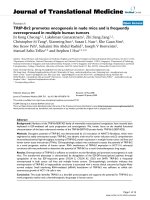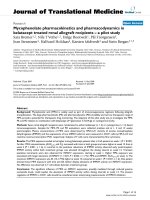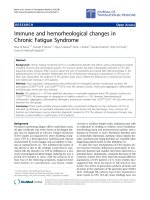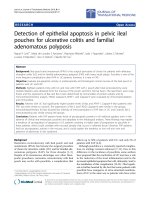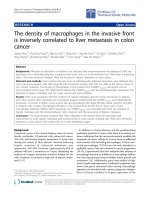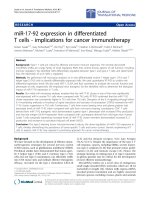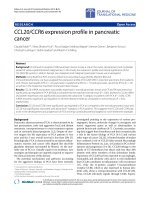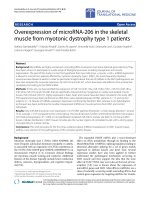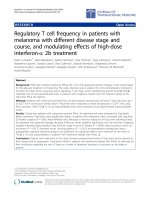báo cáo hóa học:" Cartilage contact pressure elevations in dysplastic hips: a chronic overload model" potx
Bạn đang xem bản rút gọn của tài liệu. Xem và tải ngay bản đầy đủ của tài liệu tại đây (1.72 MB, 11 trang )
BioMed Central
Page 1 of 11
(page number not for citation purposes)
Journal of Orthopaedic Surgery and
Research
Open Access
Research article
Cartilage contact pressure elevations in dysplastic hips: a chronic
overload model
Mary E Russell
2
, Kiran H Shivanna
2
, Nicole M Grosland
2,1
and
Douglas R Pedersen*
1,2
Address:
1
Department of Orthopaedics and Rehabilitation, University of Iowa, Iowa City, Iowa and
2
Department of Biomedical Engineering,
University of Iowa, Iowa City, Iowa, USA
Email: Mary E Russell - ; Kiran H Shivanna - ; Nicole M Grosland - Nicole-
; Douglas R Pedersen* -
* Corresponding author
Abstract
Background: Developmental dysplasia of the hip (DDH) is a condition in which bone growth
irregularities subject articular cartilage to higher mechanical stresses, increase susceptibility to
subluxation, and elevate the risk of early osteoarthritis. Study objectives were to calculate three-
dimensional cartilage contact stresses and to examine increases of accumulated pressure exposure
over a gait cycle that may initiate the osteoarthritic process in the human hip, in the absence of
trauma or surgical intervention.
Methods: Patient-specific, non-linear, contact finite element models, constructed from computed
tomography arthrograms using a custom-built meshing program, were subjected to normal gait
cycle loads.
Results: Peak contact pressures for dysplastic and asymptomatic hips ranged from 3.56 – 9.88
MPa. Spatially discriminatory cumulative contact pressures ranged from 2.45 – 6.62 MPa per gait
cycle. Chronic over-pressure doses, for 2 million cycles per year over 20 years, ranged from 0.463
– 5.85 MPa-years using a 2-MPa damage threshold.
Conclusion: There were significant differences between the normal control and the asymptomatic
hips, and a trend towards significance between the asymptomatic and symptomatic hips of patients
afflicted with developmental dysplasia of the hip. The magnitudes of peak cumulative contact
pressure differed between apposed articular surfaces. Bone irregularities caused localized pressure
elevations and an upward trend between chronic over-pressure exposure and increasing Severin
classification.
Background
In the absence of trauma or any surgical intervention,
patients afflicted with developmental dysplasia of the hip
(DDH) tend to develop osteoarthritis (OA) much earlier
than the population norm. Over a lifetime, chronic accu-
mulation of locally elevated cartilage stress exposure may
mechanically trigger biologic pathways leading to OA.
As a major load-bearing joint, the hip must sustain more
than three times body weight during normal human gait
Published: 03 October 2006
Journal of Orthopaedic Surgery and Research 2006, 1:6 doi:10.1186/1749-799X-1-6
Received: 17 March 2006
Accepted: 03 October 2006
This article is available from: />© 2006 Russell et al; licensee BioMed Central Ltd.
This is an Open Access article distributed under the terms of the Creative Commons Attribution License ( />),
which permits unrestricted use, distribution, and reproduction in any medium, provided the original work is properly cited.
Journal of Orthopaedic Surgery and Research 2006, 1:6 />Page 2 of 11
(page number not for citation purposes)
[1-3]. DDH is a condition in which abnormal juxtaposi-
tion of the developing femoral head and acetabulum
leads to a shallow acetabulum, femoral anteversion, and/
or capsular laxity; thus, destabilizing the hip and leaving
it prone to elevated cartilage contact pressure and sublux-
ation. Bone incongruities of DDH cause locally elevated
contact pressures on articular cartilage, and when accumu-
lated over many years, may lead to cartilage degeneration
and osteoarthritis [4-6]. Subluxation invariably leads to
degenerative joint disease[7,8].
Descriptive assessment schemes of degenerative hip dis-
ease are generally 4-bin groupings based on apparent radi-
ographic morphology, from normal to bad; Severin[9]
(DDH), Bucholtz-Ogden[10] (DDH), and Boyer[11]
(Slipped Capital Femoral Epiphysis). Little is done to dif-
ferentiate the wide range of intermediate conditions
within each group; even the 'normal' asymptomatic hip in
unilateral hip disease may be far from normal in terms of
subtle incongruities giving rise to transient cartilage stress
elevations during ordinary activities of daily living. The
chronic stress tolerance of cartilage has not been exten-
sively studied; however, it is acknowledged that spatially
averaged stress exposures may be a valid prognostic tool
for OA[12]. Hadley, et al., (1990) indicated that chronic
elevated stress exposure was likely a more significant fac-
tor in the progression of dysplasia and osteoarthritis than
acute excessive stress values.
The objective of this study was to build three-dimen-
sional, patient-specific, non-linear, contact finite element
(FE) models from computed tomography (CT) arthro-
grams to calculate continuous gait cycle articular cartilage
contact stress exposure that may initiate OA in the human
hip. From these three-dimensional contact stresses, the
cumulative pressure exposure per gait cycle was calcu-
lated, for symptomatic and asymptomatic hips. Individ-
ual peak cumulative (per gait cycle) contact pressures were
correlated with Severin classification.
Methods
We have a unique opportunity to investigate the link
between abnormal mechanical load and the earlier-than-
normal development of osteoarthritis in a natural hip in
the absence of any known trauma or surgical intervention.
All patients who had been managed with closed reduction
for developmental dysplasia of the hip at the University of
Iowa Hospital and Clinics between 1940 and 1969 were
identified[7,13]. Clinical and radiographic data were
available for 119 patients. The average duration of follow-
up in 1995 was thirty years (range, 15 to 53 years). All
radiographs were evaluated with the use of the anatomical
classification of Severin[9]. The anteroposterior radio-
graphs were also analyzed with the use of a digitizer pro-
gram[14], with regard to the acetabular angle of
Sharp[15,16], the center-edge CE-angle of Wiberg [17-19],
and ten other common measurements. Intermediate
reports have documented the progress of these
patients[7,8,20-25]. Nineteen patients consented to CT
arthrograms in addition to their standard clinical follow-
up. The arthrogram protocol involved injection of a radio-
opaque contrast agent into the joint space, which adhered
to cartilage surfaces. Then the cartilage was visible on CT
images as the dark region between the white subchondral
bone and the bright contrast-filled space between the
articulating surfaces. Radiological archives and clinical
data were used in accordance with our institution's guide-
lines for human subjects research.
A total of six dysplastic and five asymptomatic hips (six
patients) were modeled (Table 1). The average age of these
patients at closed reduction of DDH hips was 1.25 years
old, and the average age at the time of CT arthrogram
acquisition was 40 years old. An age-matched normal hip
model was generated from the 38 year old male subject of
Table 1: Patient Demographics
Patient Sex Weight (kg) Age (years) Side Affected CE angle Sharp's angles Severin score
Control M 90 38 R N n/a n/a n/a
1 M 74 39 L N 36.70 29.34 I
R Y 21.87 42.90 I
2F52 49LY 33.81 36.26 I
R Y 24.80 40.40 I
3 F 63 32 R N 28.54 35.88 I
4F51 53LY 25.20 38.85 II
R N 26.06 37.97 I
5 F 65 28 L N 32.94 39.94 I
R Y 27.83 39.20 II
6F61 42LY 14.17 49.48 III
R N 32.56 43.75 I
Journal of Orthopaedic Surgery and Research 2006, 1:6 />Page 3 of 11
(page number not for citation purposes)
the Visible Human Project
®
[26,27]. For dysplastic hips
the average Wiberg center-edge angle was 24° (range 14°–
34°) and, the average Sharp's angle was 42° (range 36°–
49°). The asymptomatic hips' average Wiberg center-edge
and Sharp's angles were 33° (range 26°–37°) and 38°
(range 29°–44°), respectively.
These patients were selected to address three issues: 1)
Normal-appearing asymptomatic hips experience near-
normal articular cartilage loading; 2) Bone irregularities
in incongruous dysplastic hips significantly elevate local
articular cartilage stresses; 3) Significant variability exists
in chronic cumulative stresses of hips scaled as normal
(Severin I).
Hip contact pressure distributions from DDH patient
models were compared to the 'normal standard' of an age-
matched hip from the Visible Human project[27]. Each FE
model was developed from the axial planes of a 3-D CT
volume. Features of interest for both the femoral head and
the acetabulum were manually traced using BRAINS2 [28-
30]. Commercially available meshing software produced
inconsistent element aspect ratios in these highly irregular
acetabular concavities. Therefore, the horseshoe shaped
cartilage coverage region on the acetabulum was deline-
ated for preferential meshing. Anatomical data were input
to a custom-written in-house mesh-generating pro-
gram[31,32] with the ability to maintain bone irregulari-
ties underlying variable thickness, smooth surface
articular cartilage. The region of cartilage coverage was
delineated and projected onto the sagittal plane, where a
regular two-dimensional quadrilateral mesh was gener-
ated (Figure 1). The 2D mesh was projected back into the
irregular 3D acetabular concavity, and expanded into the
acetabular fossa for bone surface definition[33].
Cartilage geometries required additional considerations.
For example, cartilage of uniform-thickness, generated by
Acetabular modelingFigure 1
Acetabular modeling. The region of cartilage coverage is traced and projected onto a sagittal plane, where a 2D quadrilat-
eral mesh is generated. The regular 2D mesh is projected onto the surface of the acetabulum.
Journal of Orthopaedic Surgery and Research 2006, 1:6 />Page 4 of 11
(page number not for citation purposes)
simply extruding the bone surface, included all the irregu-
larities of the bone surface. Cartilage surfaces generated
from direct outlines of the radio-opaque contrast
enhanced cartilage surfaces in CT arthrograms included
the flat spots of hip contact areas. These situations were
addressed by smoothing the articular cartilage surface
toward an ellipsoidal curvature, for both the acetabulum
and the femoral head. The resulting variable thickness of
cartilage in subsequent patient-specific FE models (0.5 to
2.8 mm, average of 1.8 mm) was similar to articular carti-
lage thicknesses observed in the CT slices[33,34].
Individual patient-specific finite element models were
meshed with roughly 5,000 and 20,000 hexahedral ele-
ments assigned to the acetabulum and femoral head,
respectively, and solved using ABAQUS (V6.4). The 3-D
FE contact models were non-linear, deformable body,
large-displacement and frictionless. The irregular femoral
head surface was covered with three layers of smooth-sur-
face, variable thickness cartilage (Young's Modulus, E = 12
MPa; Poisson's ratio, ν = 0.42). The 1-mm thick subchon-
dral bone (E = 2 GPa, ν = 0.3) of the acetabular dome was
supported by cancellous bone (E = 120 MPa, ν = 0.3) with
a fixed boundary at the medial pelvic wall (Figure 1). This
non-rigid pelvic bone support of the acetabulum exhib-
ited natural compliance that facilitated attainment of con-
tinuous horseshoe shaped contact of a normal hip
articulation[6,35,36].
Gait cycle kinematics and kinetics from the weight-bear-
ing stance phase of a 67-kg 72-year-old man with a telem-
etered femoral component total hip reconstruction[1,3]
were discretized into sixteen intervals from heel-strike
through toe-off[37]. Femoral kinematics and joint contact
force were expressed with respect to the pelvic reference
frame. Loading and displacement were applied through a
reference node whose location coincided with the com-
puted center of the femoral head. The six degrees of free-
dom were specified as 3 rotations about and 3 loads along
the three anatomical axes. The cited peak resultant loads
(Figure 2 inset) were scaled by each individual's body-
weight.
As mesh refinement of the Visible Human male 'normal
hip' model was increased, random centers of contact dur-
ing the stance phase coalesced into a broad continuous
horseshoe shaped contact area. The size of the elements
on the two contacting surfaces was progressively
decreased and peak contact pressure obtained was used
for convergence. The normal hip model solution, which
converged with 25,000 hexahedral elements, established
the reference for DDH patients' hip model load distribu-
tions (Figure 2).
The spatial and temporal involvements of the acetabular
and femoral articular cartilage were explicitly quantified
from the pressure stress, P, at the centroid of every surface
element at each of the 16 increments in the gait cycle.
ABAQUS reports the contact pressure CPRESS and the
contact area CAREA on the master surface. The apposing
contact surface stresses were extrapolated from elements
(S. Pressure): , where σ
ii
is each of the three
principal stresses. Elemental stress values greater than 0.3
MPa were identified. The sum of the respective element
face areas was consistent with the ABAQUS reported con-
tact area variable CAREA.
The per-cycle cumulative contact pressure, P
cumulative
, for
an element was
, where p
i
was the pressure on an
element during a gait cycle interval, and Δt
i
was the frac-
tion of time for that increment, (e.g., 1/16
th
of a second for
this gait cycle). The distributions of cumulative pressure
(MPa-seconds per cycle) versus contact area (mm
2
) were
also recorded. These new spatially discriminatory meas-
ures separate femoral from acetabular articular cartilage
exposure locations and magnitudes with respect to the
individual bones. To focus on the effects of patient-spe-
cific geometries, we assumed a common activity level of
two million gait cycles per year, consistent with reports
from pedometer monitored patients[38]. The cumulative
pressure in MPa-seconds per gait cycle then incorporated
typical patient activity level with three-dimensional map-
ping of focal pressure elevations due to bone irregularities
passing through the contact area.
A chronic exposure damage threshold of 2-MPa was cho-
sen for this study. The normal control had no known mus-
culoskeletal or hip problems and, at 1.229 MPa-sec/cycle
on the femoral head and 1.145 on the acetabulum (Figure
2), no spatially discriminatory cumulative pressure
exceeded this 2 MPa damage threshold. Chronic over-
pressure, P
chronic
, was calculated as
where P
i
was the pressure for an element at a specific step
in the gait cycle; P
d
was the pressure damage threshold
above which cartilage damage occurs (P
i
- P
d
≥ 0); Δt
i
was
the fraction of time that the pressure P
i
was acting on the
P =
=
∑
1
3
1
3
σ
ii
i
P
cumulative
=
⋅
()
=
∑
pt
ii
i
Δ
1
16
P
cycles
year
year
chronic
=−∗∗
∗
∗
∗
=
∑
(( ) ) ( ) (
.
PP t
id i
i
Δ
1
16
6
210
316 1
00
7
sec
)∗ N
Journal of Orthopaedic Surgery and Research 2006, 1:6 />Page 5 of 11
(page number not for citation purposes)
element; N was the number of years for which the chronic
over-pressure was being calculated. The digitized meas-
urements on 20-, 30- and 40-year follow-up films indi-
cated no major joint morphology changes with the
radiographs taken at the time of CT examination (< 3%
for all parameters). Therefore, to maintain focus on the
effects of patient-specific geometries on chronic cartilage
loading, we assumed each model was a reasonable repre-
sentation of that patient's hip for twenty years from skele-
tal maturity, and N was set to 20 years. Any contact
pressure under the chronic exposure damage threshold
was excluded as normal wear and tear (P
chronic
= 0).
Independent t-tests were performed to compare the nor-
mal control and the asymptomatic hips. Paired t-tests
measured the significance of differences between two dif-
ferent populations: the asymptomatic and symptomatic
hips, and between the acetabulae and femoral heads of
each patient. Statistical parameters included the peak
pressure, the peak cumulative pressure, the peak over-
pressure dose, and the mean contact area.
Results
Cartilage contact pressure elevations
A coronal cross-section through a patient's dysplastic hip
(Figure 3) highlighted the variable cartilage thickness
incorporated in the patient-specific modeling and also
confirmed the assumption that bone abnormalities on the
femoral head create localized supranormal pressures as
random 'bumps' make contact with the acetabulum. The
peak pressure magnitudes and the peak pressure timings
within the gait cycle (increment number) were reported
for the Visible Human control and for the 11 patient hips
(Table 2). Separate acetabular and femoral head data also
Applied loads and normal hip contact contoursFigure 2
Applied loads and normal hip contact contours. Finite element control hip contact pressure contours at each gait cycle
increment develop from the resultant contact force (inset) applied during gait stance phase kinematics.
Journal of Orthopaedic Surgery and Research 2006, 1:6 />Page 6 of 11
(page number not for citation purposes)
included the maximum accumulated pressure and the
maximum chronic over-pressure exposure, along with
Severin classification.
Chronic overload
A chronic exposure damage threshold of 2-MPa was cho-
sen for this study. The cumulative stress per gait cycle and
the chronic contact pressure spatial distribution results for
patient 6 with a Severin III dysplastic hip and a Severin I
asymptomatic hip were detailed for the acetabulum (Fig-
ure 4) and the femoral head (Figure 5). The contact pres-
sure results from 11 hips are summarized in Table 2,
alongside the normal control hip. Increment indicates the
point in the 16-interval gait cycle stance phase at which
the maximum contact pressure occurred. Statistical com-
parisons of the Table 2 results are presented in Table 3.
Discussion
Normal hip contact results for the Visible Human male
were trending towards significance or significantly differ-
ent from the asymptomatic patient hips in all calculations
(peak pressure, peak cumulative pressure, peak over-pres-
sure exposure, and mean contact area). This corroborates
the previous assertions that the contralateral hip in DDH
is also altered by the condition[39]. Therefore, it seems
reasonable to model the disease progression of OA against
Dysplastic hip cross-sectionFigure 3
Dysplastic hip cross-section. A coronal section through finite element contact pressure contours at midstance is displayed
on the isolated femoral head and acetabular articular cartilage. Note thin cartilage over a femoral 'bump' and localized peak
pressures of 8.5 MPa associated with bone irregularities present within the incongruous DDH contact area. Differences in ele-
ment size between the femoral head and the coarser acetabular mesh are accommodations for ABAQUS master-slave contact
solutions.
Journal of Orthopaedic Surgery and Research 2006, 1:6 />Page 7 of 11
(page number not for citation purposes)
the age-matched normal control of the Visible Human
male who experienced no known musculoskeletal disease
or trauma in the hip.
There was a significant reduction in contact area from the
Visible Human control to the asymptomatic acetabulae
and femoral heads. Overall calculated contact areas, rang-
ing from toe-off of a dysplastic patient (215 mm
2
)
through the midstance of the normal control (2265
mm
2
), are consistent with literature values of 759 to 2317
mm
2
at midstance[4,5,40]. Normal hip contact centered
in the postero-medial acetabular roof (Figure 2) supports
previous reports of location and extent of contact during
gait[3,6,36,41,42]. Dysplastic hip contact shifted toward
the postero-superior rim. To a lesser degree, asympto-
matic hip contact also shifted laterally (Figure 4), which is
consistent with Mavcic's observations[43].
These three-dimensional, patient-specific model solu-
tions incorporate continuous gait-cycle kinematics and
kinetics, for which comparable published models do not
exist. Therefore, results comparisons are limited to a com-
posite of reported quasi-static solutions at selected posi-
tions. The range of acetabular and femoral articular
cartilage contact pressures (1.75–8.59 MPa and 1.89–9.88
MPa, respectively) lie within the range of reported values,
from 1–10 MPa in normal and dysplastic hips[44,45].
Peak contact pressures for dysplastic and asymptomatic
hips ranged from 3.56 to 9.88 MPa. The timing of the
peak pressure did not always coincide with the peak load
during the midstance of the gait cycle (Table 2). This is a
direct consequence of bone irregularities entering the con-
tact area. Pressure magnitude is mainly dependent on the
area available for contact. Due to the incongruous surfaces
of the dysplastic hip, the changing contact area involve-
ment and the concomitant peak contact pressure do not
always coincide with the peak load.
Studies have shown that chronic transient pressure eleva-
tions on articular cartilage correlate closely with the pro-
gression and onset of OA over many years[4,12]. While
those studies extrapolated cartilage loading from clinical
antero-posterior planar radiographs, the current study uti-
lized the patients' CT arthrograms as a full 3-dimensional
window into the cumulative contact pressure distribu-
tions on cartilage[34]. For the Severin III hip of patient 6
(Table 2, Figure 5), the maximum cumulative pressure
was 6.55 MPa-per-cycle, and 5.76 MPa-years over 20-years
using a 2-MPa damage threshold. The asymptomatic hip
of that patient had maximum cumulative gait pressures
and over-pressure doses of 3.11 MPa-per-cycle and 1.83
MPa-years.
Spatially discriminatory cumulative contact pressures
ranged from 2.45 to 6.62 MPa-per-gait-cycle. Chronic
over-pressure doses, for 2 million cycles per year over 20
years, ranged from 0.463 to 5.85 MPa-years using a 2-MPa
damage threshold. The spatial distributions of elements
experiencing cumulative pressures are located within the
superior and posterior portions of the acetabulum (Figure
4). The magnitudes of peak cumulative contact pressure
differed between apposed articular surfaces, where bone
irregularities cause localized pressure elevations (Figure
5), and there is an upward trend between the chronic
over-pressure exposure and increasing Severin classifica-
tion.
These FE models include the limiting assumptions of a
common normal gait pattern and frictionless articulation.
The friction coefficient of synovial joints is very low, and
Table 2: Contact pressure data from age-matched control and all DDH patients' hips*
Control Patient 1 Patient 2 Patient 3 Patient 4 Patient 5 Patient 6
Right Left Right Left Right Right Left Right Left Right Left Right
Normal asym DDH DDH DDH asym DDH asym asym DDH DDH asym
Severin Classification I I III I II IIII III I
Acetabulum
Increment 12 12 51212 12 12 612 51212
Max pressure (MPa) 1.754 4.945 6.984 3.563 8.298 4.922 5.25 4.526 7.05 6.87 8.587 4.83
Max cum press (MPa-sec/cycle) 1.145 3.192 4.686 2.447 4.699 3.108 3.835 3.463 5.48 5.44 6.553 3.107
Max chronic press (MPa-years) 0 1.926 3.399 0.566 3.416 1.403 2.323 1.852 4.41 4.36 5.764 1.402
Femoral Head
Increment 12 12 41212 9 12 312 51212
Max pressure (MPa) 1.89 6.462 7.758 3.582 9.58 6.096 6.345 5.15 7.38 9.88 9.091 5.48
Max cum press (MPa-sec/cycle) 1.229 4.702 5.323 3.366 6.604 3.815 3.965 3.827 5.43 6.62 6.437 3.45
Max chronic press (MPa-years) 0 3.419 4.206 0.463 5.828 2.298 2.487 2.313 4.34 5.85 5.617 1.829
*DDH in bold text cells, and asym is asymptomatic contralateral hip
Journal of Orthopaedic Surgery and Research 2006, 1:6 />Page 8 of 11
(page number not for citation purposes)
there is no available direct assessment of patient differ-
ences. While it is recognized that patient-specific gait does
play a role in actual joint contact, we assume common
gait kinematics to maintain focus on the effects of patient
specific geometries on chronic cartilage loading. These
models have shown that asymptomatic hips, which may
be normal-appearing on plane radiographs, cannot be
assumed to experience the near-normal articular cartilage
loading: Results for the Visible Human male are trending
towards significance or significantly different from the
asymptomatic patient hips in all calculations. Significant
variability exists in the chronic cumulative stresses of hips
scaled as normal (Severin I). A dysplastic acetabulum has
the lowest accumulated stress per gait cycle (2.45 MPa-
sec/cycle) while an asymptomatic acetabulae records the
highest accumulated stress of 5.48 MPa-sec. Dysplastic
femoral heads have the lowest (3.37) and highest (6.6
MPa-sec/cycle) cumulative stresses.
Bone morphologic changes characteristic of a DDH
patient population with a propensity to OA, act as the
focal stress concentrators that may be the forerunner in
cartilage degeneration. As shown, the femoral head carti-
lage is much thinner over bone surface irregularities and
experiences increased pressure elevations when in contact
with its acetabular counterpart. The FE models are realistic
variable cartilage thickness 3-dimensional models with
patient-specific anatomies derived from CT scans and
incorporating pelvic thickness subchondral and cancel-
lous bone to provide a compliant support of the acetabu-
lum. The non-linear, large-displacement FE models,
incorporating continuous gait cycle kinematics and kinet-
ics, are able to discriminate not only local pressure eleva-
Asymptomatic hip contact contoursFigure 4
Asymptomatic hip contact contours. Gait cycle contact pressures on the asymptomatic acetabulum of patient 5 (Severin
Grade I).
Journal of Orthopaedic Surgery and Research 2006, 1:6 />Page 9 of 11
(page number not for citation purposes)
tions spatially, but also discriminate differences between
contact pressure elevations on the acetabulum and the
femoral head.
Conclusion
There are significant differences between the normal hip
and the asymptomatic hips and a trend towards signifi-
cance between the asymptomatic and symptomatic hips
of DDH patients. The magnitudes of peak cumulative
contact pressure differ between apposed articular surfaces.
Bone irregularities cause localized pressure elevations and
an upward trend between chronic over-pressure exposure
and increasing Severin classification.
Competing interests
The author(s) declare that they have no competing inter-
ests.
Authors' contributions
MER carried out the finite element analysis. KHS devel-
oped the code used to generate the finite element models.
NMG oversaw the model analysis and development of the
code. DRP conceived the study and participated in its
design and coordination. All authors participated in writ-
ing the manuscript. All authors read and approved the
final manuscript.
Acknowledgements
Financial support was provided by the Whitaker Foundation. Due to the
foresight of Arthur Steindler, M.D. and Ignacio Ponseti, M.D. these patients
are participants in a long-term follow-up of hip dysplasia outcomes con-
Spatial distribution of cumulative femoral contact pressureFigure 5
Spatial distribution of cumulative femoral contact pressure. (Top) Locations of femoral contact elements of Patient 6
experiencing cumulative pressure over the gait cycle and (bottom) overpressure exposure (> 2-MPa damage threshold) over
20 years.
Journal of Orthopaedic Surgery and Research 2006, 1:6 />Page 10 of 11
(page number not for citation purposes)
ducted by SL Weinstein, MD and LA Dolan, PhD at the University of Iowa
Hospitals and Clinics.
References
1. Brand RA, Pedersen DR, Davy DT, Kotzar GM, Heiple KG, Goldberg
VM: Comparison of hip force calculations and measurements
in the same patient. Journal of Arthroplasty 1994, 9(1):45-51.
2. Michaeli DA, Murphy SB, Hipp JA: Comparison of predicted and
measured contact pressures in normal and dysplastic hips.
Medical Engineering & Physics 1997, 19(2):180-186.
3. Pedersen DR, Brand RA, Davy DT: Pelvic muscle and acetabular
contact forces during gait. Journal of Biomechanics 1997,
30(9):959-965.
4. Hadley NA, Brown TD, Weinstein SL: The effects of contact pres-
sure elevations and aseptic necrosis on the long-term out-
come of congenital hip dislocation. Journal of Orthopaedic
Research 1990, 8(4):504-513.
5. Konrath GA, Hamel AJ, Guerin J, Olson SA, Bay B, Sharkey NA: Bio-
mechanical evaluation of impaction fractures of the femoral
head. Journal of Orthopaedic Trauma 1999, 13(6):407-413.
6. von Eisenhart-Rothe R, Eckstein F, Muller-Gerbl M, Landgraf J, Rock
C, Putz R: Direct comparison of contact areas, contact stress
and subchondral mineralization in human hip joint speci-
mens. Anat Embryol (Berl) 1997, 195(3):279-288.
7. Malvitz TA, Weinstein SL: Closed reduction for congenital dys-
plasia of the hip. Functional and radiographic results after an
average of thirty years. J Bone Joint Surg Am 1994,
76(12):1777-1792.
8. Weinstein SL: Natural history and treatment outcomes of
childhood hip disorders. Clin Orthop Relat Res 1997:227-242.
9. Severin E: Contribution to the Knowledge of Congenital Dis-
location of the Hip Joint. Late Results of Closed Reduction
and Arthrographic Studies of Recent Cases. Acta Chir Scandi-
navica 1941, 84(Supplement 63):.
10. Bucholz RW, Ogden JA: Patterns of ischemic necrosis of the
proximal femur in nonoperatively treated congenital hip dis-
ease. In The Hip St. Louis , C. V. Mosby Company; 1978:43-63.
11. Boyer DW, Mickelson MR, Ponseti IV: Slipped capital femoral
epiphysis. Long-term follow-up study of one hundred and
twenty-one patients. J Bone Joint Surg Am 1981, 63(1):
85-95.
12. Maxian TA, Brown TD, Weinstein SL: Chronic stress tolerance
levels for human articular cartilage: two nonuniform contact
models applied to long-term follow-up of CDH. Journal of Bio-
mechanics 1995, 28(2):159-166.
Table 3: Summary statistics between age-matched control and all DDH patients' hips
Peak Pressure (MPa) P-value Asymptomatic Mean ± S.D. DDH Mean ± S.D. Normal
Acetabulum 5.25 ± 1.02 6.59 ± 1.90 1.75
Normal v. Asymptomatic 0.0339
Asymptomatic v Symptomatic 0.0729
Femoral Head 6.11 ± 0.87 7.71 ± 2.41 1.89
Normal v. Asymptomatic 0.0116
Asymptomatic v Symptomatic 0.0302
Acetabulum v. Femoral Head 0.0021
Cumulative Pressure (MPa)
Acetabulum 3.67 ± 1.02 4.61 ± 1.40 1.15
Normal v. Asymptomatic 0.0761
Asymptomatic v Symptomatic 0.0756
Femoral Head 4.24 ± 0.81 5.39 ± 1.43 1.23
Normal v. Asymptomatic 0.0268
Asymptomatic v Symptomatic 0.0762
Acetabulum v. Femoral Head 0.0075
Chronic Overpressure (MPa-sec/cycle)
Acetabulum 2.20 ± 1.26 3.30 ± 1.77 0
Normal v. Asymptomatic 0.1865
Asymptomatic v Symptomatic 0.0402
Femoral Head 2.84 ± 1.02 4.08 ± 2.20 0
Normal v. Asymptomatic 0.0642
Asymptomatic v Symptomatic 0.0758
Acetabulum v. Femoral Head 0.0157
Contact Area (mm
2
)
Acetabulum 663 ± 55 569 ± 97 2233
Normal v. Asymptomatic 0.0008
Asymptomatic v Symptomatic 0.2482
Femoral Head 621 ± 53 614 ± 183 2265
Normal v. Asymptomatic 0.0023
Asymptomatic v Symptomatic 0.7537
Acetabulum v. Femoral Head 0.5993
Publish with BioMed Central and every
scientist can read your work free of charge
"BioMed Central will be the most significant development for
disseminating the results of biomedical research in our lifetime."
Sir Paul Nurse, Cancer Research UK
Your research papers will be:
available free of charge to the entire biomedical community
peer reviewed and published immediately upon acceptance
cited in PubMed and archived on PubMed Central
yours — you keep the copyright
Submit your manuscript here:
/>BioMedcentral
Journal of Orthopaedic Surgery and Research 2006, 1:6 />Page 11 of 11
(page number not for citation purposes)
13. Albinana J, Morcuende JA, Delgado E, Weinstein SL: Radiologic pel-
vic asymmetry in unilateral late-diagnosed developmental
dysplasia of the hip. Journal of Pediatric Orthopaedics 1995,
15(6):753-762.
14. Pedersen DR, Lamb CA, Dolan LA, Ralston HM, Weinstein SL, Mor-
cuende JA: Radiographic measurements in developmental
dysplasia of the hip: reliability and validity of a digitizing pro-
gram. Journal of Pediatric Orthopaedics 2004, 24(2):156-160.
15. Cooperman DR, Wallenstein RR, Stulberg SD: Acetabular Dyspla-
sia in the Adult. Clinical Orthopaedics & Related Research 1983,
175:79-85.
16. Sharp IK: Acetabular Dysplasia. The Acetabular Angle. Journal
of Bone & Joint Surgery - British Volume 1961, 43:268-272.
17. Fredensborg N: The CE angle of normal hips. Acta Orthopaedica
Scandinavica 1976, 47(4):403-405.
18. Fredensborg N: The results of early treatment of typical con-
genital dislocation of the hip in Malmo. J Bone Joint Surg Br 1976,
58(3):272-278.
19. Wiberg G: Studies on Dysplastic Acetabula and Congenital
Subluxation of the Hip Joint; With Special Reference to the
Complication of Osteoarthritis. Acta Chir Scandinavica 1939, 83
(Supplement 58):.
20. Ponseti IV: Causes of failure in the treatment of congenital dis-
location of the hip. J Bone Joint Surg Am 1944, 26:775-792.
21. Ponseti IV: Non-surgical treatment of congenital dislocation
of the hip. J Bone Joint Surg Am 1966, 48(7):1392-1403.
22. Ponseti IV: Morphology of the acetabulum in congenital dislo-
cation of the hip. Gross, histological and roentgenographic
studies. J Bone Joint Surg Am 1978, 60(5):586-599.
23. Ponseti IV, Frigerio ER: Results of treatment of congenital dis-
location of the hip. J Bone Joint Surg Am
1959, 41-A(5):823-846.
24. Weinstein SL, Mubarak SJ, Wenger DR: Developmental Hip Dys-
plasia and Dislocation. J Bone Joint Surg Am 2003, 85-
A(9):1824-1832.
25. Weinstein SL, Ponseti IV: Congenital dislocation of the hip. J
Bone Joint Surg Am 1979, 61(1):119-124.
26. Visible Human Project 1994 [ />visible/visible_human.html]. National Library of Medicine
27. Spitzer V, Ackerman MJ, Scherzinger AL, Whitlock D: The visible
human male: a technical report. J Am Med Inform Assoc 1996,
3(2):118-130.
28. Andreasen NC, Cizadlo T, Harris G, Swayze V 2nd, O'Leary DS,
Cohen G, Ehrhardt J, Yuh WT: Voxel processing techniques for
the antemortem study of neuroanatomy and neuropathol-
ogy using magnetic resonance imaging. J Neuropsychiatry Clin
Neurosci 1993, 5(2):121-130.
29. Andreasen NC, Cohen G, Harris G, Cizadlo T, Parkkinen J, Rezai K,
Swayze VW 2nd: Image processing for the study of brain struc-
ture and function: problems and programs. J Neuropsychiatry
Clin Neurosci 1992, 4(2):125-133.
30. Magnotta VA, Harris G, Andreasen NC, O'Leary DS, Yuh WTC,
Heckel D: Structural MR image processing using the 2 tool-
box. Computerized Medical Imaging and Graphics 2002, 26(4):251.
31. Grosland NM, Brown TD: A voxel-based formulation for con-
tact finite element analysis. Computational Methods in Biomechan-
ics and Biomedical Engineering 2002, 5(1):21-32.
32. Pedersen DR, Shivanna KH, Russell ME, Grosland NM: Transient
cartilage stress elevations in dysplastic hips. In 51st Annual
Meeting of the Orthopaedic Research Society Washington, D.C. ; 2005.
33. Shivanna KH: Automating patient-specific diarthrodial joint
contact model development. In Department of Biomedical Engi-
neering Volume Ph.D Iowa City , University of Iowa; 2006.
34. Russell ME: Cartilage Contact Pressure Elevations in Dysplas-
tic Hips: A Chronic Overload Model. In Biomedical Engineering
Volume MS. Iowa City , University of Iowa; 2005:102.
35. Hodge WA, Fijan RS, Carlson KL, Burgess RG, Harris WH, Mann
RW: Contact pressures in the human hip joint measured in
vivo. Proceedings of the National Academy of Sciences of the United
States of America 1986, 83(9):2879-2883.
36. Mavcic B, Antolic V, Brand RA, Iglic A, Ipavec M, Kralj-Iglic V, Peder-
sen DR: Weight bearing area during gait in normal and dys-
plastic hips. Pflügers Archiv 2000, 439(3 Suppl):R213-R214.
37. Maxian TA: Development and Application of a Finite Element
Formulation for Estimating Sliding Wear in Total Hip
Arthroplasty. In Biomedical Engineering Volume Ph.D.
. Iowa City ,
University of Iowa; 1997.
38. Heisel C, Silva M, Skipor AK, Jacobs JJ, Schmalzried TP: The rela-
tionship between activity and ions in patients with metal-on-
metal bearing hip prostheses. J Bone Joint Surg Am 2005,
87(4):781-7.
39. Murphy SB, Ganz R, Muller ME: The prognosis in untreated dys-
plasia of the hip. A study of radiographic factors that predict
the outcome. J Bone Joint Surg Am 1995, 77(7):985-989.
40. Olson SA, Bay BK, Pollak AN, Sharkey NA, Lee T: The effect of var-
iable size posterior wall acetabular fractures on contact
characteristics of the hip joint. Journal of Orthopaedic Trauma
1996, 10(6):395-402.
41. Mavcic B, Pompe B, Antolic V, Daniel M, Iglic A, Kralj-Iglic V: Mathe-
matical estimation of stress distribution in normal and dys-
plastic human hips. Journal of Orthopaedic Research 2002,
20(5):1025-1030.
42. von Eisenhart R, Adam C, Steinlechner M, Muller-Gerbl M, Eckstein
F: Quantitative determination of joint incongruity and pres-
sure distribution during simulated gait and cartilage thick-
ness in the human hip joint. Journal of Orthopaedic Research 1999,
17(4):532-539.
43. Mavcic B, Antolic V, Brand RA, Iglic A, Kralj-Iglic V, Pedersen DR:
Peak contact stress in human hip during gait. Pflügers Archiv
2000, 440(5 Suppl):R177-R178.
44. Brand RA: Joint contact stress: a reasonable surrogate for bio-
logical processes? Iowa Orthopaedic Journal 2005, 25:82-94.
45. Brand RA, Iglic A, Kralj-Iglic V: Contact stresses in the human
hip: implications for disease and treatment. Hip International
2001, 11(3):117-126.
